 |
 Return to Methods List |
Methods in Neuroscience Squid Giant Synapse - RECORDING - Page 2 |
| Below are photos of what happens when an action potential is evoked by current injection into the presynaptic cell and neurotransmitter is released to trigger an action potential in the postsynaptic cell. As the presynaptic cell is stimulated more and more rapidly, transmitter release fatigues and fails to trigger an action potential in the post-synpatic neuron. When stimulation is made less rapid, transmitter release quickly recovers. Recordings are made with 2 sharp, intracellular electrodes filled with 3M KCl. |
|
Fatigue of neurotransmitter release Click HERE for 3 min video (27MB) |
||
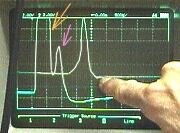 Two action potentials: the one marked by the pink arrow is partly obscured by the stimulus artifact (orange arrow). The second AP (shown by the finger) was triggered by neurotransmitter release onto the postsynaptic cell. |
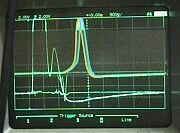 As stimuli are delivered faster and faster to the presynaptic cell, the AP triggered in the postsynaptic cell occurs at later and later time points (orange AP, then blue AP). As less neurotransmitter is secreted, the depolarization induced by neurotransmitters becomes less and it takes longer for the postsynaptic cell to reach threshold. |
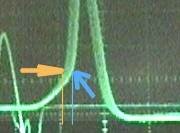 Here is a close up view of the previous photo. You can see that the AP marked by the blue arrow reaches threshold at a later time than does the AP marked with the orange arrow. |
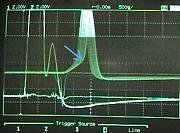 This continues to happen (blue arrow) because neurotransmitter release is being fatigued: the presynaptic nerve terminal is using up neurotransmitter-containing synaptic vesciles faster than it can recycle them. No changes can be observed in the presynaptic action potential. |
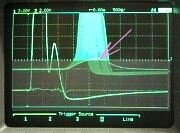 When the presynaptic cell is stimulated very rapidly, the amount of neurotransmitter available at the synpase will be insufficient to evoke an AP in the postsynaptic neuron (pink arrow) and the action potential will fail. The remaining depolarization (pink arrow) is 'subthreshold' for firing an action potential and is almost exclusively due to the activation of the neurotransmitter receptors. This potential is also called the 'receptor potential'. |
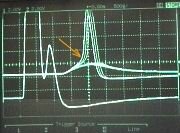 If a small increase in the time between stimuli is then allowed, neurotransmitter release will quickly recover and the depolarization becomes strong enough again to reach threshold and an action potential is fired again by the postsynaptic nerve (orange arrow shows three APs that were fired after transmitter release recovered). |
| Overview | Web Lectures | Fellowships | Activities | Home | SFN | NAS | IBRO |